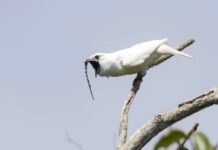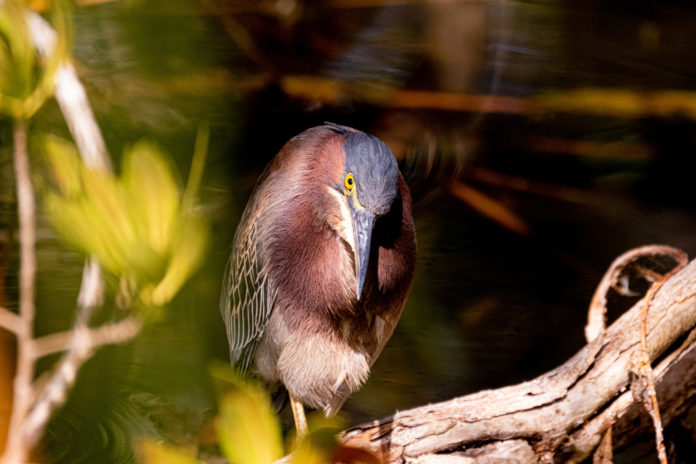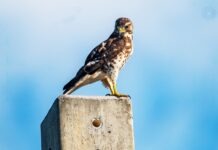I was up at the Blue Hole on Big Pine the other day, standing on the platform, staring at the gator in the shallow water below, watching her nostrils flare ever so slightly as she breathed.
She’s a small gator, 4, maybe 5, feet. From the neck down, out of immediate range of her mouth, the gator was surrounded by a small swarm of fish, all of them dark and less than an inch long, darting in and pecking at her side. It’s nice when you see something out in the wild that looks like a textbook example of a biological phenomenon – in this case, it was something called cleaning symbiosis.
It occurs between two taxonomically unrelated species, when one species – usually a much smaller one – assumes the role of cleaner and the other, larger species becomes the cleaned, or, according to the scientific literature, the client. Basically, the gator gets its scales and scutes cleaned, and the fish make a meal of the algae they remove.
There are three schools of thought as to why cleaning symbiosis happens. Some folks believe it’s an act of selfless cooperation, just two species helping each other out. Some believe it is mutual selfishness, with two species getting something they need, the well-being of the other not figuring into the equation. The third faction believes the cleaner is the only one that benefits, and that the client is either unable or unwilling to make the effort to thwart them – i.e. the gators don’t really receive much benefit from the fish, but the fish don’t do any harm, and it’s nearly impossible for a gator to catch something that small anyhow.
Honestly, I think these three camps may be more personality tests for the proponents of the theories than a crushing scientific question that demands an answer. And I’m not sure why the three evolutionary theories behind cleaning symbiosis have to be mutually exclusive. We as human beings have enough trouble understanding our own motives. Why should the entire natural world’s motives be any simpler?
But, hey, I was an English major. What do I know?
In the summer months, off to the right of the platform at the Blue Hole, there is usually a green heron nest. Sometime in early summer there will probably be a handful of fuzzy chicks there. I think every nature photographer in the Keys has been to that platform to take a picture. It’s a rite of passage of sorts.
There was no nest visible just then, but a lone green heron was sitting on one of the low branches. I rarely think of the color green when I see green herons. I think instead about how these particular birds are never the same shape twice, a kind of avian Shmoo. In this instance, though, I was thinking about color, specifically a single, slightly fancy word to describe the one I was seeing – aubergine.
Aubergine is, of course, the British word for eggplant, both the vegetable and the color. Eggplant, though, is a punchline type of a word, a word that lands with a splat. Aubergine has grace, style. It just glides out of your mouth and moves on toward better things. (Again, English major.) But aubergine has nothing to do with green.
Birds aren’t always named for their most dominant characteristic, but rather for the thing that differentiates them from similar birds. For instance, people ask why red-bellied woodpeckers are so named when their bellies aren’t all that red and their really red caps are their most notable feature. It’s because a bunch of woodpecker species have really red caps, but not many have red bellies. (The red-headed woodpecker’s whole head is red.)
The green heron used to be called the green-backed heron, which makes sense, as all its green feathers are in the back. Like many birds, it has a whole slew of previously used aliases.
It was called “little green heron” for a while, being as it is relatively little in terms of herons, and green. It was called green bittern for a while, because it looked like it could belong in the bittern subfamily of herons, though it does not.
There seem to be two types of green herons – those that are offended by the proximity of humans, and those that are not.
The one at the Blue Hole the other day was clearly unoffended. It sat and stared back at me, thoroughly nonplussed, with its tangerine-colored eyes. The ones you see in marinas, perched on low hanging boat lines, trying to fish, also fall into the non-offended category. You have to annoy them pretty well to get them to fly off. (Don’t.)
But other green herons I have encountered are less sanguine. You cross paths with them, usually unknowingly, and they fly off, exiting the scene in a bit of a huff. These quick departures gave rise to one of their better, no-longer-official names – fly-up-the-creek. It’s also the root cause of their former name Skeow, because it’s exactly the noise they make when they go.
Sometimes they defecate as they flee, an activity common to several bird species, as it both lightens the load and deters predators. That’s where two of their other discarded names come from – “chalk line,” and my all-time favorite, “shite-poke.”
Poke is another name for a bag. And shite is pretty self-explanatory, though, like aubergine, more of an English than American usage.
The whole matter does beg the question: how could the birding world go with green heron when shite-poke was an option?
























